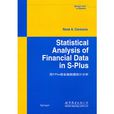《用S-Plus做金融數據統計分析》是2010年9月1日世界圖書出版公司出版的圖書,作者是(美國)卡莫納(Rene A.Carmona)。
基本介紹
- 書名:用S-Plus做金融數據統計分析
- 出版社:世界圖書出版公司
- 出版時間:2010年9月1日
- 版次:第一版
圖書信息,作者簡介,內容簡介,目錄,
圖書信息
外文書名: Statistical Analysis of Financial Data in S-Plus
平裝: 451頁
正文語種: 英語
開本: 16
ISBN: 9787510027451
條形碼: 9787510027451
尺寸: 25.8 x 18.4 x 1.4 cm
重量: 798 g
作者簡介
作者:(美國)卡莫納(Rene A.Carmona)
內容簡介
《用S-Plus做金融數據統計分析》內容簡介:This book grew out of lectures notes written for a one-semester junior statisticscourse offered to the undergraduate students majoring in the Department of Oper-ations Research and Financial Engineering at Princeton University. Tidbits of thehistory of this course will shed light on the nature and spirit of the book.
The purpose of the course is to introduce the students to modem data analysiswith an emphasis on a domain of application that is of interest to most of them:financial engineering. The prerequisites for this course are minimal, however it isfair to say that all of the students have already taken a basic introductory statisticscourse. Thus the elementary notions of random variables, expectation and correlationare taken for granted, and earlier exposure to statistical inference (estimation, testsand confidence intervals) is assumed. It is also expected that the students are familiarwith a minimum of linear algebra as well as vector and matrix calculus.
目錄
Part Ⅰ DATA EXPLORATION, ESTIMATION AND SIMULATION
UNIVARIATE EXPLORATORY DATA ANALYSIS
1.1 Data, Random Variables and Their Distributions
1.1.1 The PCS Data
1.1.2 The S&P 500 Index and Financial Returns
1.1.3 Random Variables and Their Distributions
1.1.4 Examples of Probability Distribution Families.,
1.2 First Exploratory Data Analysis Tools
1.2.1 Random Samples
1.2.2 Histograms
1.3 More Nonparametric Density Estimation
1.3.1 Kernel Density Estimation
1.3.2 Comparison with the Histogram
1.3.3 S&P Daily Returns
1.3.4 Importance of the Choice of the Bandwidth
1.4 Quantiles and Q-Q Plots
1.4.1 Understanding the Meaning of Q-Q Plots
1.4.2 Value at Risk and Expected Shortfall
1.5 Estimation from Empirical Data
1.5.1 The Empirical Distribution Function
1.5.2 Order Statistics
1.5.3 Empirical Q-Q Plots
1.6 Random Generators and Monte Carlo Samples
1.7 Extremes and Heavy Tail Distributions
1.7.1 S&P Daily Returns, Once More
1.7.2 The Example of the PCS Index
1.7.3 The Example of the Weekly S&P Returns
Problems
Notes & Complements
2 MULTIVARIATE DATA EXPLORATION
2.1 Multivariate Data and First Measure of Dependence
2.1.1 Density Estimation
2.1.2 The Correlation Coefficient
2.2 The Multivariate Normal Distribution
2.2.1 Simulation of Random Samples
2.2.2 The Bivariate Case
2.2.3 A Simulation Example
2.2.4 Let's Have Some Coffee
2.2.5 Is the Joint Distribution Normal?
2.3 Marginals and More Measures of Dependence
2.3.1 Estimation of the Coffee Log-Return Distributions
2.3.2 More Measures of Dependence
2.4 Copulas and Random Simulations
2.4.1 Copulas
2.4.2 First Examples of Copula Families
2.4.3 Copulas and General Bivariate Distributions
2.4.4 Fitting Copulas
2.4.5 Monte Carlo Simulations with Copulas
2.4.6 A Risk Management Example
2.5 Principal Component Analysis
2.5.1 Identification of the Principal Components of a Data Set
2.5.2 PCA with S-Plus
2.5.3 Effective Dimension of the Space of Yield Curves
2.5.4 Swap Rate Curves
Appendix 1: Calculus with Random Vectors and Matrices
Appendix 2: Families of Copulas
Problems
Notes & Complements
Part Ⅱ REGRESSION
3 PARAMETRIC REGRESSION
3.1 Simple Linear Regression
3.1.1 Getting the Data
3.1.2 First Plots
3.1.3 Regression Set-up
3.1.4 Simple Linear Regression
3.1.5 Cost Minimizations
3.1.6 Regression as a Minimization Problem
3.2 Regression for Prediction & Sensitivities
3.2.1 Prediction
3.2.2 Introductory Discussion of Sensitivity and Robustness
3.2.3 Comparing L2 and L1 Regressions
3.2.4 Taking Another Look at the Coffee Data
3.3 Smoothing versus Distribution Theory
3.3.1 Regression and Conditional Expectation
3.3.2 Maximum Likelihood Approach
3.4 Multiple Regression
3.4.1 Notation
3.4.2 The S-Plus Function im
3.4.3 R2 as a Regression Diagnostic
3.5 Matrix Formulation and Linear Models
3.5.1 Linear Models
3.5.2 Least Squares (Linear) Regression Revisited
3.5.3 First Extensions
3.5.4 Testing the CAPM
3.6 Polynomial Regression
3.6.1 Polynomial Regression as a Linear Model
3.6.2 Example of S- Plus Commands
3.6.3 Important Remark
3.6.4 Prediction with Polynomial Regression
3.6.5 Choice of the Degree p
3.7 Nonlinear Regression
3.8 Term Structure of Interest Rates: A Crash Course
3.9 Parametric Yield Curve Estimation
3.9.1 Estimation Procedures
3.9.2 Practical Implementation
3.9.3 S- Plus Experiments
3.9.4 Concluding Remarks
Appendix: Cautionary Notes on Some S-Plus Idiosyncracies
Problems
Notes & Complements
LOCAL & NONPARAMETRIC REGRESSION
4.1 Review of the Regression Setup
4.2 Natural Splines as Local Smoothers
4.3 Nonparametric Scatterplot Smoothers
4.3.1 Smoothing Splines
4.3.2 Locally Weighted Regression
4.3.3 A Robust Smoother
4.3.4 The Super Smoother
4.3.5 The Kernel Smoother
4.4 More Yield Curve Estimation
4.4.1 A First Estimation Method
4.4.2 A Direct Application of Smoothing Splines
4.4.3 US and Japanese Instantaneous Forward Rates
4.5 Multivariate Kernel Regression
4.5.1 Running the Kernel in S-plus
4.5.2 An Example Involving the June 1998 S&P Futures Contra
4.6 Projection Pursuit Regression
4.6.1 The S-Plus Functionppreg
4.6.2 ppreg Prediction of the S&P Indicators
4.7 Nonparametric Option Pricing
4.7.1 Generalities on Option Pricing
4.7.2 Nonparametric Pricing Alternatives
4.7.3 Description of the Data
4.7.4 The Actual Experiment
4.7.5 Numerical Results
Appendix: Kernel Density Estimation & Kernel Regression
Problems
Notes & Complements
Part Ⅲ TIME SERIES & STATE SPACE MODELS
5 TIME SERIES MODELS: AR, MA, ARMA, & ALL THAT
5.1 Notation and First Definitions
5.1.1 Notation
5.1.2 Regular Time Series and Signals
5.1.3 Calendar and Irregular Time Series
5.1.4 Example of Dally S&P 500 Futures Contracts
5.2 High Frequency Data
5.2.1 TimeDate Manipulations
5.3 Time Dependent Statistics and Stationarity
5.3.1 Statistical Moments
5.3.2 The Notion of Stationarity
5.3.3 The Search for Stationarity
5.3.4 The Example of the C02 Concentrations
5.4 First Examples of Models
5.4.1 White Noise
5.4.2 Random Walk
5.4.3 Auto Regressive Time Series
5.4.4 Moving Average Time Series
5.4.5 Using the Backward Shift Operator B
5.4.6 Linear Processes
5.4:7 Causality, Stationarity and Invertibility
5.4.8 ARMA Time Series
5.4.9 ARIMA Models
5.5 Fitting Models to Data
5.5.1 Practical Steps
……

